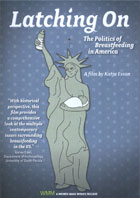
Latching On: The Politics of Breastfeeding in America 2010
Distributed by Women Make Movies, 462 Broadway, New York, NY 10013; 212-925-0606
Produced by Penelope Pictures, LLC
Directed by Katja Esson
DVD, color, 36 min.
College - Adult
Health Sciences, Women's Studies, Sociology
Date Entered: 10/21/2010
Reviewed by Lori Widzinski, Health Sciences Library, University at Buffalo, State University of New YorkFrom the opening scenes, Latching On delves into the reasons that the United States and New York City in particular, have some of the lowest rates for breastfeeding in the world. Director Katja Esson compares the breastfeeding experiences of her sister in Germany with those of her friends in New York City. In Germany her sister breastfed in public anytime and anywhere she wanted to; in the U.S. it is something that is not seen very often in public places, and if it is, it is done as discreetly as possible.
New mothers and moms-to-be relate their experiences (and much of the film is centered) on a visit to The Upper Breast Side, a boutique located in Manhattan’s Upper West Side neighborhood. The owner, Felina, opened the shop after finding a dearth of resources when she wanted to breastfeed her first child. Lactation consultants, physicians, and “person in the street” interviews all weigh-in on the importance of breastfeeding and the lack of promotion, support and plain old common sense for new parents in the United States.
The economics of breastfeeding seem to be the driving force behind how the U.S. has developed into a somewhat “closeted” country in this regard. According to the film, it is easier to get formula to your newborn than for new parents to insist they want to breastfeed immediately after birth. The amount of money invested in formula and the amount of free formula available discourages many women from breastfeeding. One sociological phenomena highlighted in the film is the lack of breastfeeding by African-American women in our culture. Those that do breastfeed are often doing it for economic reasons—not being able to afford formula—rather than doing it for the health of the baby.
Several statistics are given to illustrate the major ideas in the film; unfortunately their sources are not, leaving one to wonder how current and accurate they really are. While most could be easily tracked, (that New York City has the lowest rate of breastfeeding in the United States; The United States has one of the lowest breastfeeding rates in the world; 3 billion dollars is spent annually on formula in the U.S.; and the monumental drop in home births and breastfeeding since the 1950s) they would be more effective and produce a stronger argument if they were cited and explained. There is one that is particularly curious: 3.6 billion dollars in health care costs could be avoided by breastfeeding. Perhaps this is true and aside from the lack of citation, does the number refer to baby-boomer adults or children between certain ages? What year? What country?
Unfortunately, this lack of detail is somewhat indicative of the film itself. The ideas in Latching On are important ones, yet the continuity of themes is unfocused. The transition between ideas never develops and results in a feeling of being bounced back and forth between concepts. The tone of the interviewees is problematic: those relating personal testimonies too often feel like complaints and the professionals have a forceful, defensive edge. Because of these problems, the film is unbalanced. Tackling a topic like this in 36 minutes is no small feat, and precise editing to carry out the supporting points of view is essential. Another minor quibble is that the subtitle indicates an exploration of the political side of breastfeeding, yet politics plays a minor role the picture. A more accurate subtitle for the film would be “The Socioeconomics of Breastfeeding in America.”
If one is looking for a film to expose the lack of support for breastfeeding in the U.S., then Latching On will serve as an introduction to the pro-breastfeeding side. However, for use in higher education classrooms, it needs more balance and depth—definitive clarification of statistical claims illustrated with voices of national leaders in the field—and for those reasons is recommended with reservations.